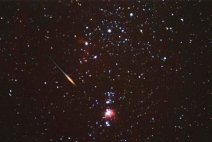

 A Meteor is the proper name for the streak of light that is usually called a shooting star. Meteors are caused when specks of dust about the size of grains of sand dash into the upper atmosphere from space. Moving at upto 45 kilometres per second the friction from travelling through air creates intense heat and they burn up giving off a bright light. Some of these bits of dust are singular pieces of debris flying through the solar system and getting swept up by the planets. Others travel in swarms of meteoric dust. Each time the earth passes through one of these swarms it causes a meteor shower. These groups of meteoric dust are left by passing comets which have had material blown off them by solar winds. The earth crosses the orbit of several comets every year and this is when we see meteor showers such as the Leonids or Perseids.
A Meteor is the proper name for the streak of light that is usually called a shooting star. Meteors are caused when specks of dust about the size of grains of sand dash into the upper atmosphere from space. Moving at upto 45 kilometres per second the friction from travelling through air creates intense heat and they burn up giving off a bright light. Some of these bits of dust are singular pieces of debris flying through the solar system and getting swept up by the planets. Others travel in swarms of meteoric dust. Each time the earth passes through one of these swarms it causes a meteor shower. These groups of meteoric dust are left by passing comets which have had material blown off them by solar winds. The earth crosses the orbit of several comets every year and this is when we see meteor showers such as the Leonids or Perseids.
How many meteors can be seen during a meteor shower ?
The term meteor shower is a bit misleading. It suggests that meteors are falling like rain. This isn't the case. What you will find is an increase in the number of meteors over what you would see on an average night. Different showers have different intensities, ranging from 10 to over 100 meteors an hour.
When is the best time to observe meteors ?
Unfortunately for most of us who live near towns or cities a lot of the fainter meteors are washed out by light pollution. However during the Perseids shower (25th July to 18th August) or Leonids (15-19th November) you should still be able to see a meteor every few minutes. It is worth spending a bit of time outside during one of the these showers as a bright meteor is one of the most exciting sights in the night sky.
What is the difference between a meteor and a meteorite ?
Unlike a meteor which is a grain of dust, a meteorite is a fragment of rock that succeeds in reaching the ground. They are very uncommon and there are no reports of anyone being hurt by a meteorite. They are generally fairly small but one monster (the Hoba West meteorite) which fell in Namibia during prehistoric times weighs in at over 60 tonnes.
